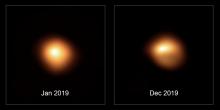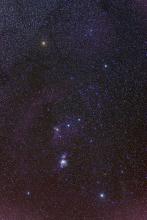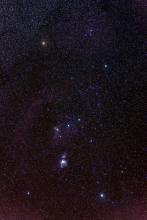Listen to today's episode of StarDate on the web the same day it airs in high-quality streaming audio without any extra ads or announcements. Choose a $8 one-month pass, or listen every day for a year for just $30.
You are here
Busy Betelgeuse
Betelgeuse lost some of its luster in recent months. By early this year, the supergiant star was fainter than it had been in a long time. That dropped it not only from the top 10 brightest stars in the night sky, but from the top 20. And astronomers are trying to figure out what that means.
Betelgeuse forms the shoulder of Orion the hunter. It’s high in the southwest as night falls, and shines bright orange.
The star is one of the most impressive in our part of the galaxy. It’s a dozen or more times the mass of the Sun, and hundreds of times the Sun’s diameter. If it took the Sun’s place, in fact, it would engulf the four inner planets, including Earth. And it might reach all the way to the fifth planet, Jupiter.
That’s the star’s average size. Betelgeuse puffs in and out like a beating heart, getting bigger and smaller with each beat — and brighter and fainter.
Its recent fade, though, made it fainter than has ever been recorded with modern instruments. That led to speculation that Betelgeuse was about to explode as a supernova. And someday, it will — in the next hundred thousand years or so.
Instead, Betelgeuse might have appeared so faint because it has several overlapping “beats,” and two of them reached their low points at the same time. Or perhaps the star expelled a lot of dust, creating a dense “fog” around itself.
Whatever the reason, astronomers say this impressive star is likely to hang around for a long time to come.
Script by Damond Benningfield





